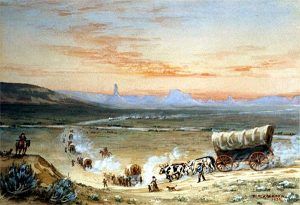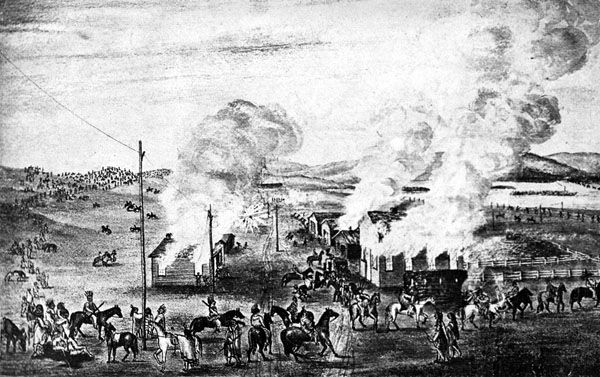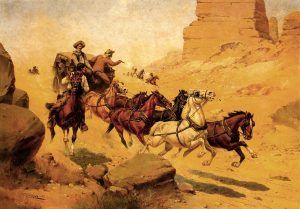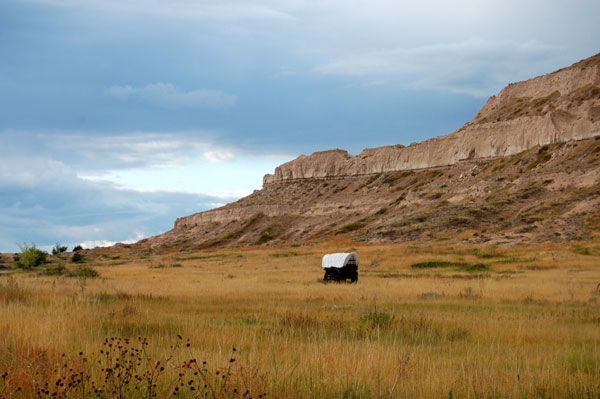
American Indian Wars
The white man takes our property without paying for it! He kills our game, he eats our meat, he burns our wood, he drinks our water, and he travels our country, and what does he give the red man in exchange for all this?
— Marto-cogershne, Sioux chief, as reported by fur trader Rufus B. Sage, 1841 emigration
Once-friendly Western tribes watched with mounting anger as emigrants helped themselves, often wastefully, to their game, grass, water, and wood. Indian agents warned of bloody conflicts ahead if the issues between native peoples and emigrants were not soon resolved. In response, the U.S. government called for a treaty conference to be held near Fort Laramie, Wyoming, in September 1851. Some 12,000 members of 11 different Northern Plains tribes answered the call, gathering at Horse Creek in western Nebraska for the “Big Talk.” Over a period of about three weeks, native leaders and government representatives worked out an agreement, the Fort Laramie Treaty of 1851, to guarantee long-term peace along the trails.
The agreement was undone three years later by a stray cow. In mid-August 1854, just a few miles east of Fort Laramie, a cow from a Mormon emigrant train bolted into a trailside camp of Brule Lakota, who slaughtered it for food. In response to complaints by the cow’s owner, Lieutenant John Grattan led a detachment of soldiers out of Fort Laramie to confront the Indians in their camp. Grattan provoked a firefight that ended with his 31-man command — and the respected Brule leader, Conquering Bear — dead.
As punishment for the Grattan defeat, U.S. Army troops under General William Harney surrounded and destroyed a Brule Lakota village at Blue Water Creek, Nebraska, in September 1855. Many fleeing women, children, and defending warriors died in the attack. This and similar military actions against the Plains Indians over the next several years fanned smoldering resentment into burning outrage. Small bands of young warriors struck back in 1862–63 by opportunistically attacking isolated homesteads, work parties, and freight teamsters in Colorado and Nebraska. Then, for 12 sweltering August days in 1864, Indian military strikes forced travel on the Great Platte River Road to a halt.
The Platte Valley is ours, and we do not intend to give it away. We have let the white man have it so that he could pass, but he has gone over it so often now that he claims it and thinks he owns it. But it is still ours and always has been ours.
— Brule Sioux Chief Sinte-Galeska (Spotted Tail), 1864
Along the Little Blue River and up the Platte River to Julesburg, Colorado, war parties of Cheyenne, Lakota, and Arapaho fighters made coordinated attacks on emigrant wagons, freight teams, and stagecoaches on the emigrant trails. They particularly targeted lonely homesteads, stage stations, and road ranches — simple hostels that served travelers on the wagon trails — along the Little Blue River. There, warriors killed 51 white adults and children and took seven hostages, several of whom died during captivity or shortly after their release months later. The number of Indian fighters killed is unrecorded.
The U.S. Army could ill afford to divert soldiers from its Civil War fronts to the Nebraska frontier. The company sent from Fort Kearny to secure the emigrant trails was outnumbered, out-horsed, and outdistanced by the Indians. Pawnee men, though, were glad to help the Army fight their old enemies, and more than 100 of them volunteered for duty as frontier scouts.
The Indians have committed terrible depredations along three hundred miles of the route, burned and pillaged everything, destroyed six thousand bushels of corn at Julesburg, burned hundreds of thousands of dollars’ worth of wagons, merchandise, etc.
— Demas Barnes, a passenger on Overland Stage on the Oregon-California Trail, 1865
Fighting continued across Nebraska, Colorado, and Wyoming the next year, with native leaders now targeting telegraph lines, stage lines, railroads, forts, and settlements to halt the emigration and regain control of their native territory. In response, entire Army regiments were assigned to protect the trail, with soldiers stationed at small outposts, road ranches, and telegraph stations along the road west of Fort Kearny, Nebraska. Attacks and counter-attacks by both sides flared over the Plains through the 1860s, causing many established settlers to flee Nebraska. Despite the danger, emigrants still poured into the West. The fighting did not truly end until the Lakota and Cheyenne people were finally forced onto reservations in the 1870s.
Though they fought for the U.S., the Pawnee fared no better: white settlement pressures, starvation, and a final, disastrous battle with the Lakota forced them out of their Nebraska homeland. The tribe moved to Oklahoma in 1873–75 and sold its Loup River reservation.
Most overland trail traffic ended in 1869 with the transcontinental railroad’s completion, which provided a faster, safer way West. The era of the overland wagon was drawing to a close, and the era of the fuel-powered steam engine and the automobile was dawning. Some of those who traveled the Great Platte River Road with ox and wagon would live to see their dusty, rutted trail become a modern paved highway. Those pioneers took about six weeks to cover the nearly 500 miles along the Platte from the Missouri River to Scotts Bluff. Today’s travelers can make the drive on Interstate 80 in less than eight hours.
Compiled by Kathy Alexander/Legends of America, January 2023. Source: National Park Service
Also See:




